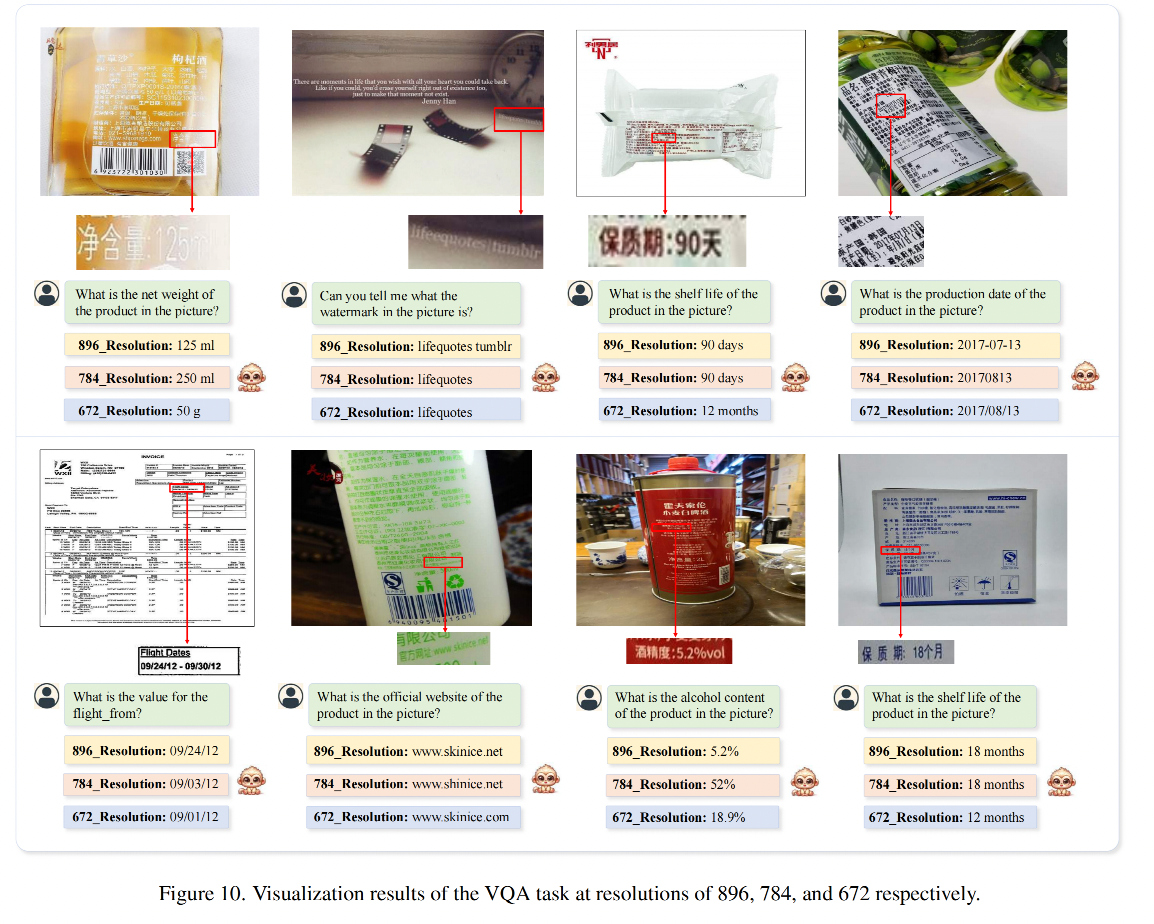RK3566(泰山派):3.1寸屏幕D310T9362V1SPEC触摸驱动(竖屏)
文章目录
- RK3566(泰山派):3.1寸屏幕D310T9362V1SPEC触摸驱动(竖屏)
- 电路
- 配置i2c1设备树
- 创建驱动
- 编写Makefile
- my_touch.c驱动
- I2C驱动框架
- 驱动中的结构体
- probe
- 竖屏probe函数
- 横屏probe函数
- 中断
- 中断线程服务函数
- 竖屏中断线程服务函数
- 横屏中断线程服务函数
- TD_STATUS
- TOUCHn_X寄存器
- TOUCHn_Y寄存器
- 上报数据
- 触摸驱动完整代码
- 编译生效
- 效果
电路
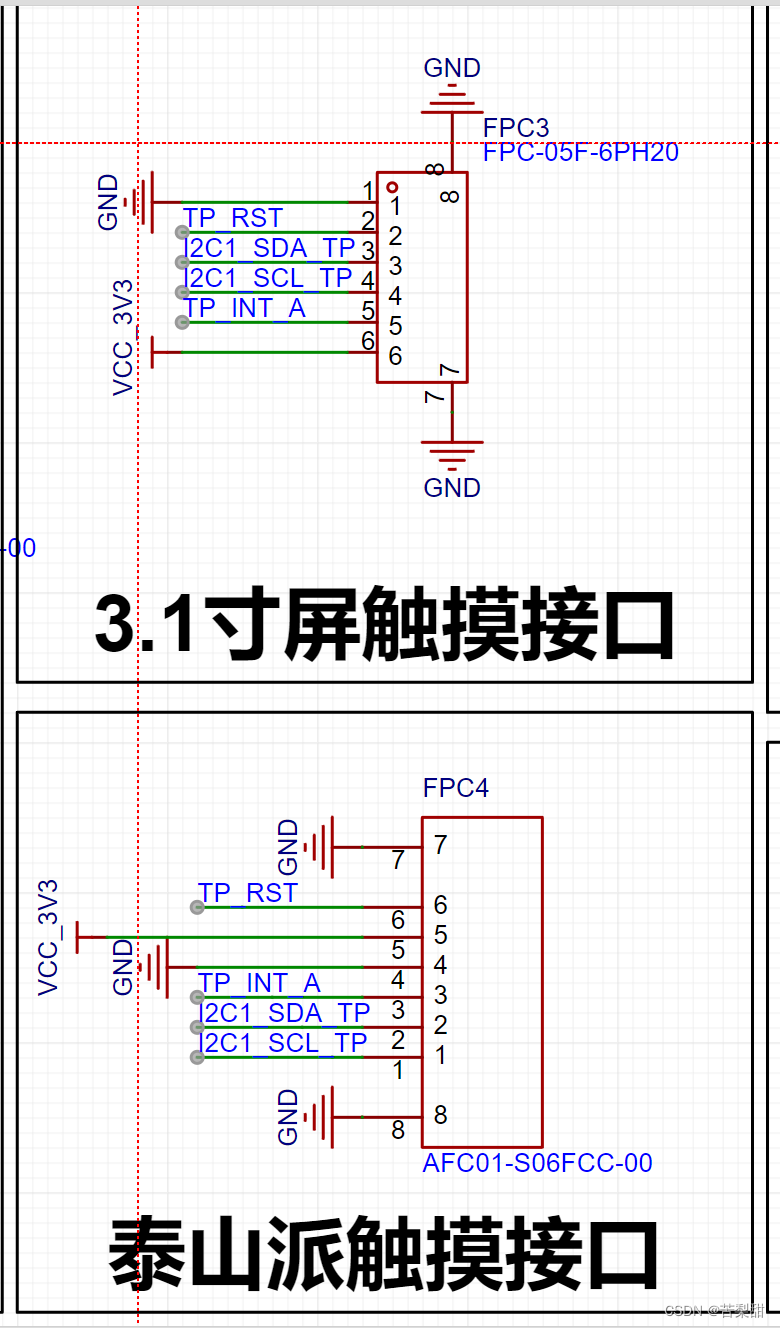
配置i2c1设备树
从原理图中可知GP7101和触摸共同挂在道I2C下,所以引用&i2c1并添加一个我们自己定义的myts@38触摸节点。
&i2c1 {status = "okay"; // 表示这个i2c1设备是可用的clock-frequency = <400000>; // 设置i2c1的时钟频率为400kHzmyts@38 { // 定义一个i2c设备,设备地址为0x38,设备名称为mytscompatible = "my,touch"; // 表示这个设备是触摸屏设备,驱动名称为my,touchreg = <0x38>; // i2c设备地址tp-size = <89>; // 触摸屏的大小max-x = <480>; // 触摸屏支持的最大X坐标值max-y = <800>; // 触摸屏支持的最大Y坐标值touch-gpio = <&gpio1 RK_PA0 IRQ_TYPE_LEVEL_LOW>; // 触摸屏的触摸中断引脚,连接到gpio1的第0个引脚,触发方式为低电平触发reset-gpio = <&gpio1 RK_PA1 GPIO_ACTIVE_HIGH>; // 触摸屏的复位引脚,连接到gpio1的第1个引脚,有效电平为高电平};/****省略****/
};
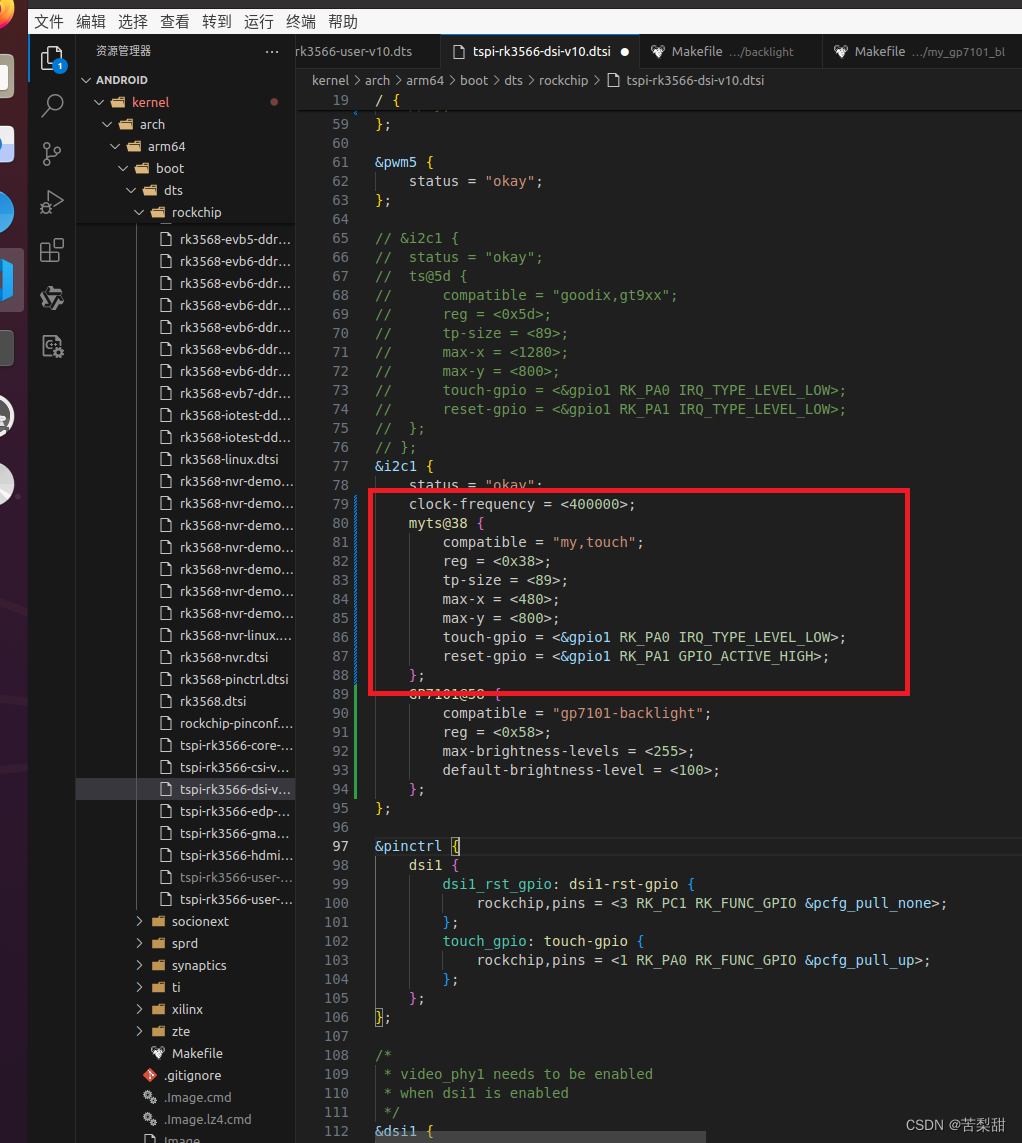
创建驱动
一般触摸都放在
/kernel/drivers/input/touchscreen目录下,所以我们在此路径下创建一个my_touch目录用来存放Makefile和my_touch.c文件。
/home/paranoid/tspi/android/kernel/drivers/input/touchscreen
cd kernel/drivers/input/touchscreen
mkdir my_touch
cd my_touch/
touch Makefile
touch my_touch.c
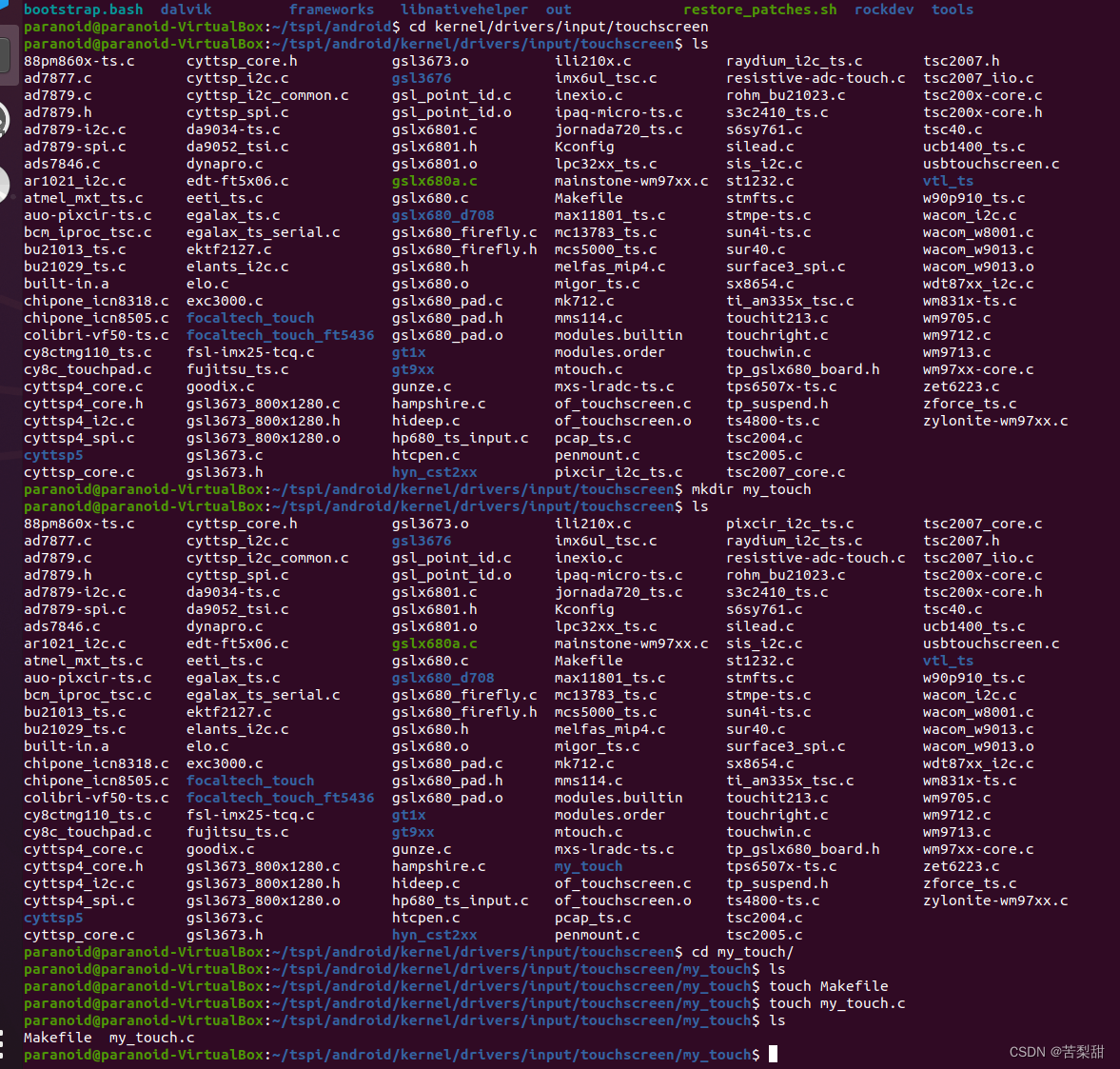
编写Makefile
touchscreen/Makefile中把my_touch.c编译到内核中,当然也可以选择obj-m编译成模块。
obj-y += my_touch.o
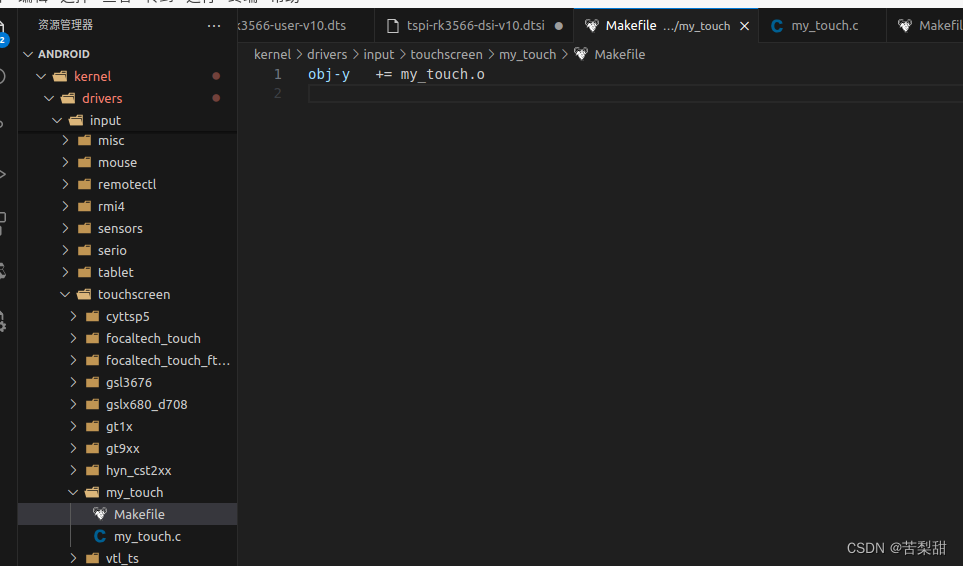
要想
my_touch下的Makefile生效还需要在上一层目录的Makefile中添加my_touch目录,所以我们需要在touchscreen目录下Makefile中加入:注释掉官方SDK的触摸驱动
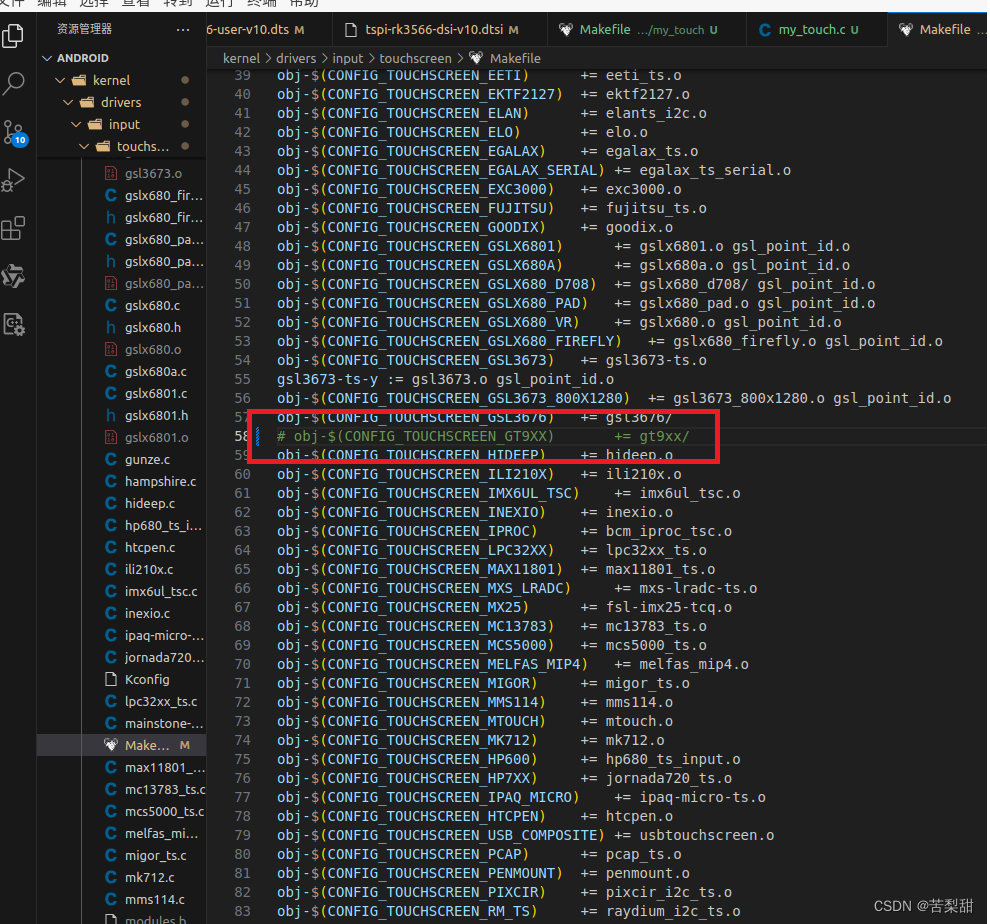
添加自己写的驱动
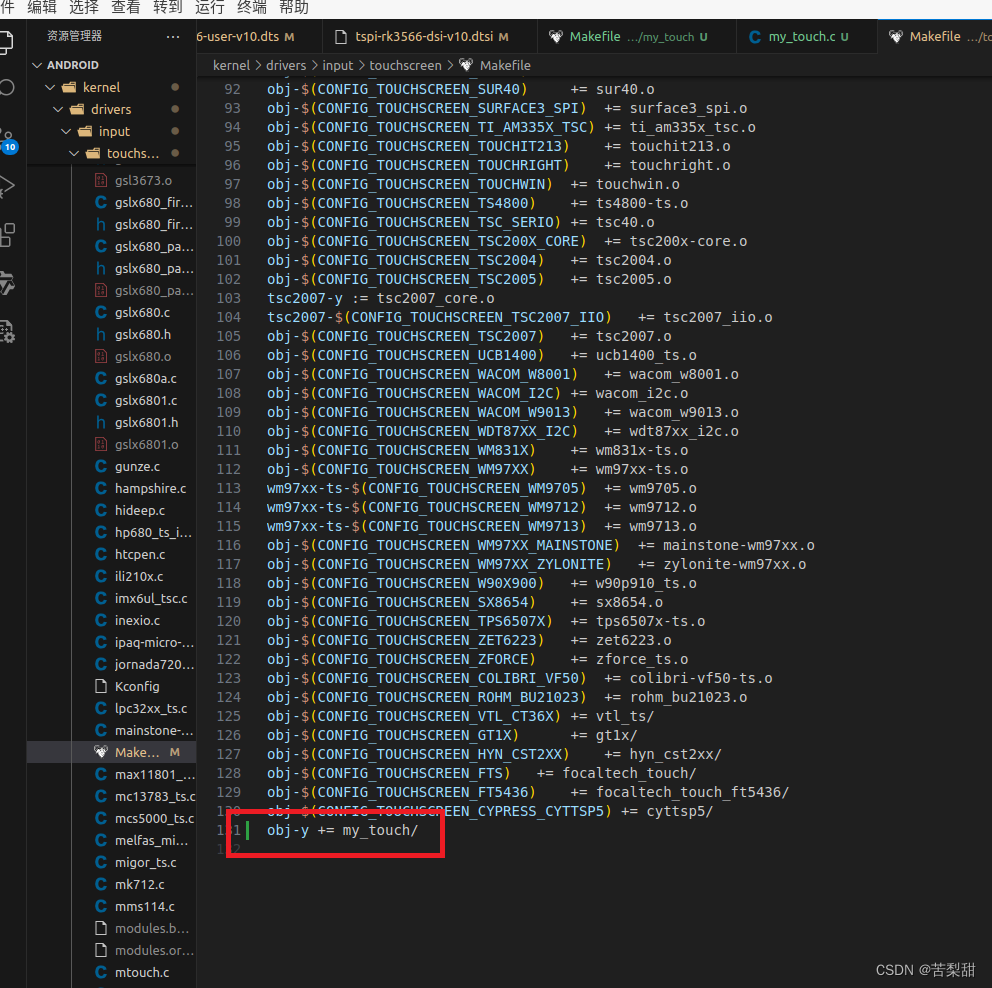
my_touch.c驱动
I2C驱动框架
一个框架结构。
static int my_touch_ts_probe(struct i2c_client *client,const struct i2c_device_id *id)
{return 0;
}static int my_touch_ts_remove(struct i2c_client *client)
{MY_DEBUG("locat");return 0;
}static const struct of_device_id my_touch_of_match[] = {{ .compatible = "my,touch", },{ /* sentinel */ }
};
MODULE_DEVICE_TABLE(of, my_touch_of_match);static struct i2c_driver my_touch_ts_driver = {.probe = my_touch_ts_probe,.remove = my_touch_ts_remove,.driver = {.name = "my-touch",.of_match_table = of_match_ptr(my_touch_of_match),},
};static int __init my_ts_init(void)
{MY_DEBUG("locat");return i2c_add_driver(&my_touch_ts_driver);
}static void __exit my_ts_exit(void)
{MY_DEBUG("locat");i2c_del_driver(&my_touch_ts_driver);
}module_init(my_ts_init);
module_exit(my_ts_exit);MODULE_LICENSE("GPL");
MODULE_DESCRIPTION("My touch driver");
MODULE_AUTHOR("KuLiT");
驱动中的结构体
因为驱动过程中会有很多参数,我们不可能创建全局变量去保存他们,在linux驱动中一般都是通过创建一个结构体来保存驱动相关的参数,所以这里创建一个my_touch_dev结构体。
// 定义一个表示触摸设备的结构体
struct my_touch_dev {struct i2c_client *client; // 指向与触摸设备通信的 I2C 客户端结构体的指针struct input_dev *input_dev; // 指向与输入设备关联的 input_dev 结构体的指针,用于处理输入事件int rst_pin; // 触摸设备的复位引脚编号int irq_pin; // 触摸设备的中断引脚编号u32 abs_x_max; // 触摸设备在 X 轴上的最大绝对值u32 abs_y_max; // 触摸设备在 Y 轴上的最大绝对值int irq; // 触摸设备的中断号
};
probe
当驱动中of_match_table = of_match_ptr(my_touch_of_match)和设备树匹配成功以后会执行探针函数,探针函数中我们会去初始化驱动。
竖屏probe函数
static int my_touch_ts_probe(struct i2c_client *client,const struct i2c_device_id *id)
{int ret; // 定义一个返回值变量struct my_touch_dev *ts; // 定义一个结构体指针,用来指向my_touch_dev结构体struct device_node *np = client->dev.of_node; // 获取设备节点// 打印调试信息MY_DEBUG("locat"); // 调用MY_DEBUG函数打印调试信息,此处打印"locat"ts = devm_kzalloc(&client->dev, sizeof(*ts), GFP_KERNEL); // 使用devm_kzalloc分配内存,减少内存申请操作if (ts == NULL){ // 检查内存分配是否成功dev_err(&client->dev, "Alloc GFP_KERNEL memory failed."); // 内存分配失败,打印错误信息return -ENOMEM; // 返回内存申请错误的码}ts->client = client; // 触摸屏设备的客户端指针指向i2c_client结构体i2c_set_clientdata(client, ts); // 将my_touch_dev结构体的指针设置为i2c客户端的数据// 从设备树中读取触摸屏的最大X和Y值if (of_property_read_u32(np, "max-x", &ts->abs_x_max)) {dev_err(&client->dev, "no max-x defined\n"); // 如果读取最大X值失败,打印错误信息return -EINVAL; // 返回参数无效的错误码}MY_DEBUG("abs_x_max:%d",ts->abs_x_max); // 打印X值if (of_property_read_u32(np, "max-y", &ts->abs_y_max)) {dev_err(&client->dev, "no max-y defined\n"); // 如果读取最大Y值失败,打印错误信息return -EINVAL; // 返回参数无效的错误码}MY_DEBUG("abs_x_max:%d",ts->abs_y_max); // 打印Y值// 获取并请求复位GPIO管脚ts->rst_pin = of_get_named_gpio(np, "reset-gpio", 0); // 从设备树中获取复位管脚ret = devm_gpio_request(&client->dev,ts->rst_pin,"my touch touch gpio"); // 请求使用复位管脚if (ret < 0){ // 如果请求失败dev_err(&client->dev, "gpio request failed."); // 打印错误信息return -ENOMEM; // 返回内存申请错误的码}ts->irq_pin = of_get_named_gpio(np, "touch-gpio", 0); // 从设备树中获取中断管脚ret = devm_gpio_request_one(&client->dev, ts->irq_pin, // 请求使用中断管脚GPIOF_IN, "my touch touch gpio");if (ret < 0)return ret; // 如果请求失败,直接返回错误码// 复位触摸屏设备gpio_direction_output(ts->rst_pin,0); // 设置复位管脚输出低电平msleep(20); // 等待20毫秒gpio_direction_output(ts->irq_pin,0); // 设置中断管脚输出低电平msleep(2); // 等待2毫秒gpio_direction_output(ts->rst_pin,1); // 设置复位管脚输出高电平msleep(6); // 等待6毫秒gpio_direction_output(ts->irq_pin, 0); // 设置中断管脚输出低电平msleep(50); // 等待50毫秒// 申请中断服务ts->irq = gpio_to_irq(ts->irq_pin); // 将GPIO管脚转换为中断号if(ts->irq){ // 检查中断号是否有效ret = devm_request_threaded_irq(&(client->dev), ts->irq, // 请求线程化中断NULL, my_touch_irq_handler, // 中断服务函数IRQF_TRIGGER_FALLING | IRQF_ONESHOT, // 中断触发方式为下降沿触发,且只触发一次client->name, ts);if (ret != 0) {MY_DEBUG("Cannot allocate ts INT!ERRNO:%d\n", ret); // 如果中断请求失败,打印错误信息return ret; // 返回错误码}}// 使用devm_input_allocate_device分配输入设备对象ts->input_dev = devm_input_allocate_device(&client->dev); if (!ts->input_dev) { // 检查输入设备对象是否分配成功dev_err(&client->dev, "Failed to allocate input device.\n"); // 打印错误信息return -ENOMEM; // 返回内存申请错误的码}// 设置输入设备的名称ts->input_dev->name = "my touch screen"; // 设置输入设备的总线类型为I2Cts->input_dev->id.bustype = BUS_I2C; // 设置X轴的最大值为480input_set_abs_params(ts->input_dev, ABS_MT_POSITION_X, 0, 480, 0, 0); // 设置Y轴的最大值为800input_set_abs_params(ts->input_dev, ABS_MT_POSITION_Y, 0, 800, 0, 0); // 初始化5个多点触摸槽位,直接模式ret = input_mt_init_slots(ts->input_dev, 5, INPUT_MT_DIRECT); if (ret) {dev_err(&client->dev, "Input mt init error\n"); // 打印错误信息return ret; // 返回错误码}// 注册输入设备ret = input_register_device(ts->input_dev); // 注册输入设备if (ret)return ret; // 返回错误码// 读取版本号gt9271_read_version(client); return 0; // 如果一切顺利,返回0
}
横屏probe函数
static int my_touch_ts_probe(struct i2c_client *client,const struct i2c_device_id *id)
{int ret;struct my_touch_dev *ts;struct device_node *np = client->dev.of_node;u8 addr[1] = {0x00};u8 point_data[1]={00};//1个状态位置+5个触摸点,一个点是6个数据组成// 打印调试信息MY_DEBUG("locat");// ts = kzalloc(sizeof(*ts), GFP_KERNEL);ts = devm_kzalloc(&client->dev, sizeof(*ts), GFP_KERNEL);if (ts == NULL){dev_err(&client->dev, "Alloc GFP_KERNEL memory failed.");return -ENOMEM;}ts->client = client;i2c_set_clientdata(client, ts);if (of_property_read_u32(np, "max-x", &ts->abs_x_max)) {dev_err(&client->dev, "no max-x defined\n");return -EINVAL;}MY_DEBUG("abs_x_max:%d",ts->abs_x_max);if (of_property_read_u32(np, "max-y", &ts->abs_y_max)) {dev_err(&client->dev, "no max-y defined\n");return -EINVAL;}MY_DEBUG("abs_x_max:%d",ts->abs_y_max);//找复位gpiots->rst_pin = of_get_named_gpio(np, "reset-gpio", 0);//申请复位gpioret = devm_gpio_request(&client->dev,ts->rst_pin,"my touch touch gpio");if (ret < 0){dev_err(&client->dev, "gpio request failed.");return -ENOMEM;}//找中断引进ts->irq_pin = of_get_named_gpio(np, "touch-gpio", 0);/* 申请使用管脚 */ret = devm_gpio_request_one(&client->dev, ts->irq_pin,GPIOF_IN, "my touch touch gpio");if (ret < 0)return ret;/*reset 复位屏幕,如果屏幕没有成功被复位触摸是无法产生中断的*/gpio_direction_output(ts->rst_pin,0);msleep(20); gpio_direction_output(ts->irq_pin,0);msleep(2); gpio_direction_output(ts->rst_pin,1);msleep(6); gpio_direction_output(ts->irq_pin, 0);gpio_direction_output(ts->irq_pin, 0);msleep(50);//申请中断ts->irq = gpio_to_irq(ts->irq_pin); if(ts->irq){ret = devm_request_threaded_irq(&(client->dev), ts->irq, NULL, my_touch_irq_handler, IRQF_TRIGGER_FALLING | IRQF_ONESHOT , client->name, ts);if (ret != 0) {MY_DEBUG("Cannot allocate ts INT!ERRNO:%d\n", ret);return ret;}}// 分配输入设备对象ts->input_dev = devm_input_allocate_device(&client->dev);if (!ts->input_dev) {dev_err(&client->dev, "Failed to allocate input device.\n");return -ENOMEM;}// 设置输入设备的名称和总线类型ts->input_dev->name = "my touch screen";ts->input_dev->id.bustype = BUS_I2C;/*设置触摸 x 和 y 的最大值*/// 设置输入设备的绝对位置参数,假如你的触摸出现范围很小的情况就是这值不对input_set_abs_params(ts->input_dev, ABS_MT_POSITION_X, 0, 480, 0, 0);input_set_abs_params(ts->input_dev, ABS_MT_POSITION_Y, 0, 800, 0, 0);// 初始化多点触摸设备的槽位ret = input_mt_init_slots(ts->input_dev, 5, INPUT_MT_DIRECT);if (ret) {dev_err(&client->dev, "Input mt init error\n");return ret;}// 注册输入设备ret = input_register_device(ts->input_dev);if (ret)return ret;my_touch_i2c_write(ts->client, addr,sizeof(addr), point_data, sizeof(point_data));gt9271_read_version(client);return 0;
}
中断
读取触摸数据有很多方法比如轮询但是这样效率太低了,所以我们这里通过中断方式实现触摸数据读取,当屏幕被触控时,屏幕会通过irq引脚输出中断信号。
devm_request_threaded_irq(&(client->dev), ts->irq, // 请求线程化中断NULL, my_touch_irq_handler, // 中断服务函数IRQF_TRIGGER_FALLING | IRQF_ONESHOT, // 中断触发方式为下降沿触发,且只触发一次client->name, ts);
中断线程服务函数
上面中断以后当屏幕被触摸会触发中断线程服务函数my_touch_irq_handler,在这个函数里面我们通过i2c去读取屏幕相关的参数。
竖屏中断线程服务函数
static irqreturn_t my_touch_irq_handler(int irq, void *dev_id)
{s32 ret = -1; // 定义一个返回值,初始化为-1struct my_touch_dev *ts = dev_id; // 获取指向设备数据的指针u8 addr[1] = {0x02}; // 定义一个寄存器地址数组对应数据手册TD_STATUS u8 point_data[1+6*5]={0}; // 定义一个点数据数组,预留足够空间 for 5 touch pointsu8 touch_num = 0; // 定义一个变量来存储触摸点的数量u8 *touch_data; // 定义一个指针用于指向点数据int i = 0; // 定义一个循环变量int event_flag, touch_id, input_x, input_y; // 定义一些用于存储事件信息的变量MY_DEBUG("irq"); // 打印中断信息ret = my_touch_i2c_read(ts->client, addr, sizeof(addr), point_data, sizeof(point_data)); // 尝试读取触摸屏设备的数据if (ret < 0){ // 如果读取失败MY_DEBUG("I2C write end_cmd error!"); // 打印错误信息}touch_num = point_data[0]&0x0f; // 获取触摸点的数量MY_DEBUG("touch_num:%d",touch_num); // 打印触摸点数量// 遍历触摸点数据for(i=0; i<5; i++){// 获取触摸点数据touch_data = &point_data[1+6*i];/*解析触摸点的事件标志位00b: 按下01b: 抬起10b: 接触11b: 保留*/event_flag = touch_data[0] >> 6;if(event_flag == 0x03)continue; // 如果事件标志位不是按下或抬起,则跳过此循环touch_id = touch_data[2] >> 4; // 获取触摸点IDMY_DEBUG("i:%d touch_id:%d event_flag:%d",i,touch_id,event_flag); // 打印调试信息input_x = ((touch_data[0]&0x0f)<<8) | touch_data[1]; // 计算X坐标input_y = ((touch_data[2]&0x0f)<<8) | touch_data[3]; // 计算Y坐标// MY_SWAP(input_x,input_y); // 如果需要交换X和Y坐标,可以取消注释此行MY_DEBUG("i:%d,x:%d,y:%d",i,input_x,input_y); // 打印调试信息// 设置输入设备的触摸槽位input_mt_slot(ts->input_dev, touch_id);if(event_flag == 0){ // 如果是按下// 上报按下事件和坐标input_mt_report_slot_state(ts->input_dev, MT_TOOL_FINGER, true); // 设置为按下状态input_report_abs(ts->input_dev, ABS_MT_POSITION_X, 480-input_x); // 报告X坐标input_report_abs(ts->input_dev, ABS_MT_POSITION_Y, input_y); // 报告Y坐标}else if (event_flag == 2){ // 如果是长按// 直接上报数据input_report_abs(ts->input_dev, ABS_MT_POSITION_X, 480-input_x); // 报告X坐标input_report_abs(ts->input_dev, ABS_MT_POSITION_Y, input_y); // 报告Y坐标else if(event_flag == 1){ // 如果是触摸抬起// 上报事件input_mt_report_slot_state(ts->input_dev, MT_TOOL_FINGER, false); // 设置为抬起状态}}// 报告输入设备的指针仿真信息input_mt_report_pointer_emulation(ts->input_dev, true);// 同步输入事件input_sync(ts->input_dev);// 返回IRQ_HANDLED,表示中断已经被处理return IRQ_HANDLED;
}
横屏中断线程服务函数
/*
1.中断来了,进入这里面,既然来中断证明屏幕被触摸了。
2.读取屏幕里面的触摸数据,每个屏幕不一样但是方法是一样怎么读my_touch_i2c_read读哪里
3.解析数据
4.上报数据*/
static irqreturn_t my_touch_irq_handler(int irq, void *dev_id)
{s32 ret = -1;struct my_touch_dev *ts = dev_id;u8 addr[1] = {0x02};u8 point_data[1+6*5]={0};//1个状态位置+5个触摸点,一个点是6个数据组成u8 touch_num = 0;u8 *touch_data;int i = 0;int event_flag, touch_id, input_x, input_y;MY_DEBUG("irq");ret = my_touch_i2c_read(ts->client, addr,sizeof(addr), point_data, sizeof(point_data));if (ret < 0){MY_DEBUG("I2C write end_cmd error!");}touch_num = point_data[0]&0x0f;MY_DEBUG("touch_num:%d",touch_num);//获取for(i=0; i<5; i++){//获取点touch_data = &point_data[1+6*i];/*00b: Put Down 01b: Put Up 10b: Contact 11b: Reserved*///TOUCHn_XH[7:6]event_flag = touch_data[0] >> 6;MY_DEBUG("event_flag:%d",event_flag);if(event_flag == 0x03)continue; touch_id = touch_data[2] >> 4;MY_DEBUG("i:%d touch_id:%d event_flag:%d",i,touch_id,event_flag);input_x = ((touch_data[0]&0x0f)<<8) | touch_data[1];input_y = ((touch_data[2]&0x0f)<<8) | touch_data[3];// MY_SWAP(input_x,input_y);MY_DEBUG("i:%d,x:%d,y:%d",i,input_x,input_y);// 设定输入设备的触摸槽位input_mt_slot(ts->input_dev, touch_id);if(event_flag == 0){// 如果是按下上报按下和坐标input_mt_report_slot_state(ts->input_dev, MT_TOOL_FINGER, true);input_report_abs(ts->input_dev, ABS_MT_POSITION_X, 480-input_x);input_report_abs(ts->input_dev, ABS_MT_POSITION_Y, input_y);}else if (event_flag == 2){// 如果是长按直接上报数据input_report_abs(ts->input_dev, ABS_MT_POSITION_X, 480-input_x);input_report_abs(ts->input_dev, ABS_MT_POSITION_Y, input_y);}else if(event_flag == 1){// 触摸抬起,上报事件input_mt_report_slot_state(ts->input_dev, MT_TOOL_FINGER, false);}}// 报告输入设备的指针仿真信息input_mt_report_pointer_emulation(ts->input_dev, true);// 同步输入事件input_sync(ts->input_dev);return IRQ_HANDLED;
}
TD_STATUS
读取数据从TD_STATUS开始,一个触摸点包含6个数据分别是TOUCH1_XH、TOUCH1_XL、TOUCH1_YH、TOUCH1_YL、TOUCH1_WEIGHT,共计支持5点触控,所以连续读取的长度为1(TD_STATUS)+6(数据)*5。
ret = my_touch_i2c_read(ts->client, addr, sizeof(addr), point_data, sizeof(point_data));
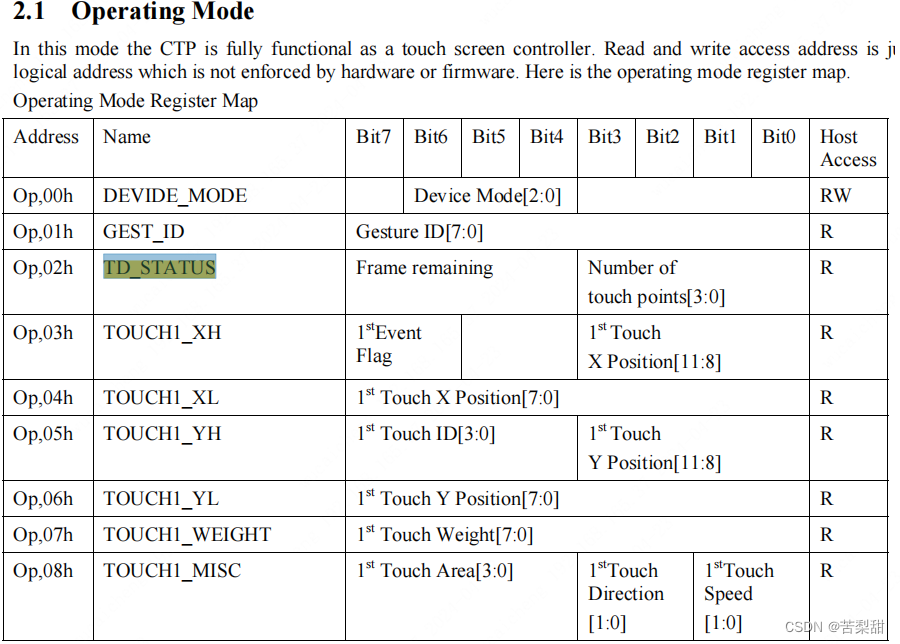
TD_STATUS寄存器中的[3:0]位存储的是触摸点数据,所以我们通过下面语句读取到当前有多少点被按下。
touch_num = point_data[0]&0x0f; // 获取触摸点的数量
TOUCHn_X寄存器
TOUCHn_XH寄存器的[7:6]位是事件标志位数,所以我们通过touch_data右移6位来获取[7:6]位值。通过判定这个标志位我们可以知道当前触摸状态。
值类型:
- 触摸:00b
- 抬起:01b
- 长按:10b
- 保留:11b
event_flag = touch_data[0] >> 6;
TOUCHn_XH寄存器的[3:0]位是x坐标的高[11:8]位数,要想获取完整的x坐标值需要把TOUCHn_XH的[3:0]位和TOUCHn_XL的[7:0]位进行组合。
input_x = ((touch_data[0]&0x0f)<<8) | touch_data[1];
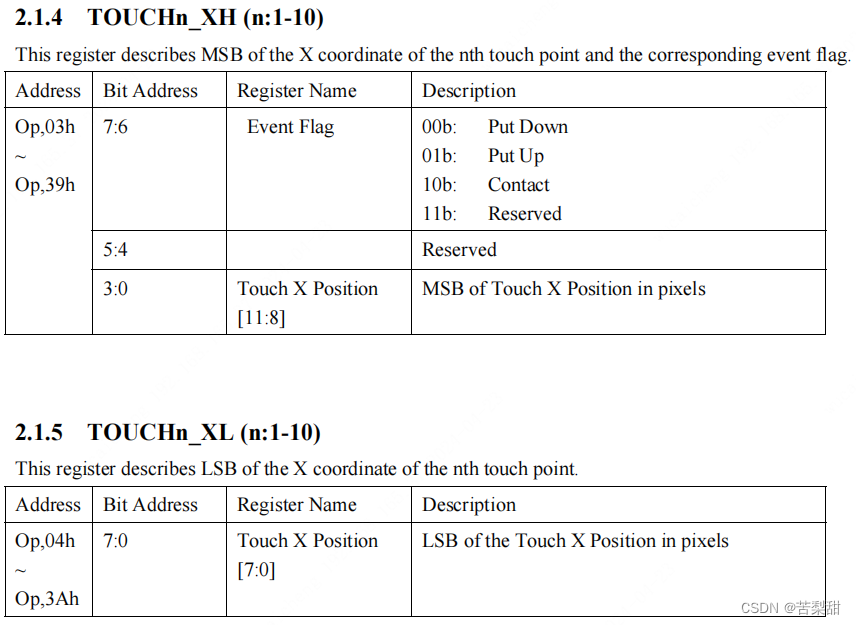
TOUCHn_Y寄存器
TOUCHn_YH寄存器的[7:4]位是触摸ID,通过右移4位获取到触摸id。
touch_id = touch_data[2] >> 4; // 获取触摸点ID
TOUCHn_YH寄存器的[3:0]位是y坐标的高[11:8]位数,要想获取完整的x坐标值需要把TOUCHn_YH的[3:0]位和TOUCHn_YL的[7:0]位进行组合。
input_y = ((touch_data[2]&0x0f)<<8) | touch_data[3]; // 计算Y坐标
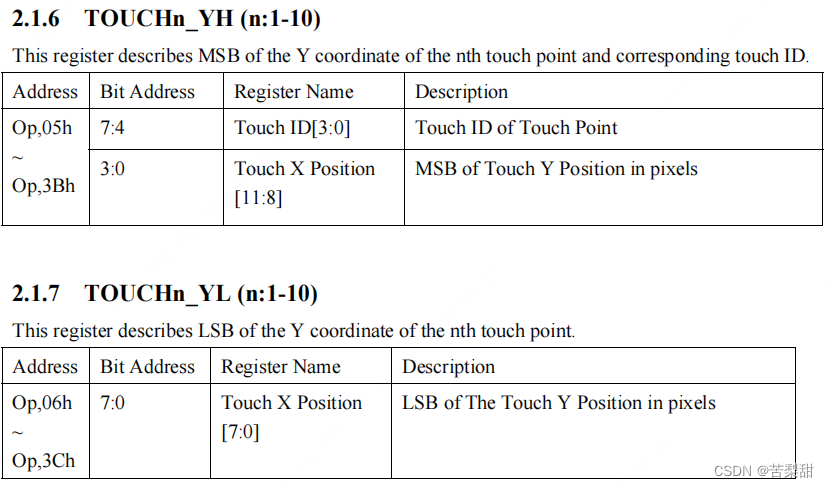
上报数据
数据到以后调用input接口函数进行数据上报,详细的函数使用方法大家看代码里面的注释。
触摸驱动完整代码
#include "linux/stddef.h"
#include <linux/kernel.h>
#include <linux/hrtimer.h>
#include <linux/i2c.h>
#include <linux/input.h>
#include <linux/module.h>
#include <linux/delay.h>
#include <linux/i2c.h>
#include <linux/proc_fs.h>
#include <linux/string.h>
#include <linux/uaccess.h>
#include <linux/vmalloc.h>
#include <linux/interrupt.h>
#include <linux/io.h>
#include <linux/of_gpio.h>
#include <linux/gpio.h>
#include <linux/slab.h>
#include <linux/timer.h>
#include <linux/input/mt.h>
#include <linux/random.h>#define MY_SWAP(x, y) do{\typeof(x) z = x;\x = y;\y = z;\}while (0)#if 1
#define MY_DEBUG(fmt,arg...) printk("MY_TOUCH:%s %d "fmt"",__FUNCTION__,__LINE__,##arg);
#else
#define MY_DEBUG(fmt,arg...)
#endifstruct my_touch_dev {struct i2c_client *client;struct input_dev *input_dev;int rst_pin;int irq_pin;u32 abs_x_max;u32 abs_y_max;int irq;
};s32 my_touch_i2c_read(struct i2c_client *client,u8 *addr,u8 addr_len, u8 *buf, s32 len)
{struct i2c_msg msgs[2];s32 ret=-1;msgs[0].flags = !I2C_M_RD;msgs[0].addr = client->addr;msgs[0].len = addr_len;msgs[0].buf = &addr[0];msgs[1].flags = I2C_M_RD;msgs[1].addr = client->addr;msgs[1].len = len;msgs[1].buf = &buf[0];ret = i2c_transfer(client->adapter, msgs, 2);if(ret == 2)return 0;if(addr_len == 2){MY_DEBUG("I2C Read: 0x%04X, %d bytes failed, errcode: %d! Process reset.", (((u16)(addr[0] << 8)) | addr[1]), len, ret);}else {MY_DEBUG("I2C Read: 0x%02X, %d bytes failed, errcode: %d! Process reset.", addr[0], len, ret);}return -1;
}s32 my_touch_i2c_write(struct i2c_client *client, u8 *addr, u8 addr_len, u8 *buf,s32 len)
{struct i2c_msg msg;s32 ret = -1;u8 *temp_buf;msg.flags = !I2C_M_RD;msg.addr = client->addr;msg.len = len+addr_len;temp_buf= kzalloc(msg.len, GFP_KERNEL);if (!temp_buf){goto error;}// 装填地址memcpy(temp_buf, addr, addr_len);// 装填数据memcpy(temp_buf + addr_len, buf, len);msg.buf = temp_buf;ret = i2c_transfer(client->adapter, &msg, 1);if (ret == 1) {kfree(temp_buf);return 0;}error:if(addr_len == 2){MY_DEBUG("I2C Read: 0x%04X, %d bytes failed, errcode: %d! Process reset.", (((u16)(addr[0] << 8)) | addr[1]), len, ret);}else {MY_DEBUG("I2C Read: 0x%02X, %d bytes failed, errcode: %d! Process reset.", addr[0], len, ret);}if (temp_buf)kfree(temp_buf);return -1;
}/*
1.中断来了,进入这里面,既然来中断证明屏幕被触摸了。
2.读取屏幕里面的触摸数据,每个屏幕不一样但是方法是一样怎么读my_touch_i2c_read读哪里
3.解析数据
4.上报数据*/
static irqreturn_t my_touch_irq_handler(int irq, void *dev_id)
{s32 ret = -1;struct my_touch_dev *ts = dev_id;u8 addr[1] = {0x02};u8 point_data[1+6*5]={0};//1个状态位置+5个触摸点,一个点是6个数据组成u8 touch_num = 0;u8 *touch_data;int i = 0;int event_flag, touch_id, input_x, input_y;MY_DEBUG("irq");ret = my_touch_i2c_read(ts->client, addr,sizeof(addr), point_data, sizeof(point_data));if (ret < 0){MY_DEBUG("I2C write end_cmd error!");}touch_num = point_data[0]&0x0f;MY_DEBUG("touch_num:%d",touch_num);//获取for(i=0; i<5; i++){//获取点touch_data = &point_data[1+6*i];/*00b: Put Down 01b: Put Up 10b: Contact 11b: Reserved*///TOUCHn_XH[7:6]event_flag = touch_data[0] >> 6;MY_DEBUG("event_flag:%d",event_flag);if(event_flag == 0x03)continue; touch_id = touch_data[2] >> 4;MY_DEBUG("i:%d touch_id:%d event_flag:%d",i,touch_id,event_flag);input_x = ((touch_data[0]&0x0f)<<8) | touch_data[1];input_y = ((touch_data[2]&0x0f)<<8) | touch_data[3];// MY_SWAP(input_x,input_y);MY_DEBUG("i:%d,x:%d,y:%d",i,input_x,input_y);// 设定输入设备的触摸槽位input_mt_slot(ts->input_dev, touch_id);if(event_flag == 0){// 如果是按下上报按下和坐标input_mt_report_slot_state(ts->input_dev, MT_TOOL_FINGER, true);input_report_abs(ts->input_dev, ABS_MT_POSITION_X, 480-input_x);input_report_abs(ts->input_dev, ABS_MT_POSITION_Y, input_y);}else if (event_flag == 2){// 如果是长按直接上报数据input_report_abs(ts->input_dev, ABS_MT_POSITION_X, 480-input_x);input_report_abs(ts->input_dev, ABS_MT_POSITION_Y, input_y);}else if(event_flag == 1){// 触摸抬起,上报事件input_mt_report_slot_state(ts->input_dev, MT_TOOL_FINGER, false);}}// 报告输入设备的指针仿真信息input_mt_report_pointer_emulation(ts->input_dev, true);// 同步输入事件input_sync(ts->input_dev);return IRQ_HANDLED;
}s32 gt9271_read_version(struct i2c_client *client)
{s32 ret = -1;u8 addr[1] = {0xA1};u8 buf[3] = {0};ret = my_touch_i2c_read(client, addr,sizeof(addr), buf, sizeof(buf));if (ret < 0){MY_DEBUG("GTP read version failed");return ret;}if (buf[5] == 0x00){MY_DEBUG("IC Version: %0x %0x_%02x", buf[0], buf[1], buf[2]);}else{MY_DEBUG("IC Version: %0x %0x_%02x", buf[0], buf[1], buf[2]);}return ret;
}static int my_touch_ts_probe(struct i2c_client *client,const struct i2c_device_id *id)
{int ret;struct my_touch_dev *ts;struct device_node *np = client->dev.of_node;u8 addr[1] = {0x00};u8 point_data[1]={00};//1个状态位置+5个触摸点,一个点是6个数据组成// 打印调试信息MY_DEBUG("locat");// ts = kzalloc(sizeof(*ts), GFP_KERNEL);ts = devm_kzalloc(&client->dev, sizeof(*ts), GFP_KERNEL);if (ts == NULL){dev_err(&client->dev, "Alloc GFP_KERNEL memory failed.");return -ENOMEM;}ts->client = client;i2c_set_clientdata(client, ts);if (of_property_read_u32(np, "max-x", &ts->abs_x_max)) {dev_err(&client->dev, "no max-x defined\n");return -EINVAL;}MY_DEBUG("abs_x_max:%d",ts->abs_x_max);if (of_property_read_u32(np, "max-y", &ts->abs_y_max)) {dev_err(&client->dev, "no max-y defined\n");return -EINVAL;}MY_DEBUG("abs_x_max:%d",ts->abs_y_max);//找复位gpiots->rst_pin = of_get_named_gpio(np, "reset-gpio", 0);//申请复位gpioret = devm_gpio_request(&client->dev,ts->rst_pin,"my touch touch gpio");if (ret < 0){dev_err(&client->dev, "gpio request failed.");return -ENOMEM;}//找中断引进ts->irq_pin = of_get_named_gpio(np, "touch-gpio", 0);/* 申请使用管脚 */ret = devm_gpio_request_one(&client->dev, ts->irq_pin,GPIOF_IN, "my touch touch gpio");if (ret < 0)return ret;/*reset 复位屏幕,如果屏幕没有成功被复位触摸是无法产生中断的*/gpio_direction_output(ts->rst_pin,0);msleep(20); gpio_direction_output(ts->irq_pin,0);msleep(2); gpio_direction_output(ts->rst_pin,1);msleep(6); gpio_direction_output(ts->irq_pin, 0);gpio_direction_output(ts->irq_pin, 0);msleep(50);//申请中断ts->irq = gpio_to_irq(ts->irq_pin); if(ts->irq){ret = devm_request_threaded_irq(&(client->dev), ts->irq, NULL, my_touch_irq_handler, IRQF_TRIGGER_FALLING | IRQF_ONESHOT , client->name, ts);if (ret != 0) {MY_DEBUG("Cannot allocate ts INT!ERRNO:%d\n", ret);return ret;}}// 分配输入设备对象ts->input_dev = devm_input_allocate_device(&client->dev);if (!ts->input_dev) {dev_err(&client->dev, "Failed to allocate input device.\n");return -ENOMEM;}// 设置输入设备的名称和总线类型ts->input_dev->name = "my touch screen";ts->input_dev->id.bustype = BUS_I2C;/*设置触摸 x 和 y 的最大值*/// 设置输入设备的绝对位置参数,假如你的触摸出现范围很小的情况就是这值不对input_set_abs_params(ts->input_dev, ABS_MT_POSITION_X, 0, 480, 0, 0);input_set_abs_params(ts->input_dev, ABS_MT_POSITION_Y, 0, 800, 0, 0);// 初始化多点触摸设备的槽位ret = input_mt_init_slots(ts->input_dev, 5, INPUT_MT_DIRECT);if (ret) {dev_err(&client->dev, "Input mt init error\n");return ret;}// 注册输入设备ret = input_register_device(ts->input_dev);if (ret)return ret;my_touch_i2c_write(ts->client, addr,sizeof(addr), point_data, sizeof(point_data));gt9271_read_version(client);return 0;
}static int my_touch_ts_remove(struct i2c_client *client)
{struct my_touch_dev *ts = i2c_get_clientdata(client);MY_DEBUG("locat");input_unregister_device(ts->input_dev);return 0;
}static const struct of_device_id my_touch_of_match[] = {{ .compatible = "my,touch", },{ /* sentinel */ }
};
MODULE_DEVICE_TABLE(of, my_touch_of_match);static struct i2c_driver my_touch_ts_driver = {.probe = my_touch_ts_probe,.remove = my_touch_ts_remove,.driver = {.name = "my-touch",.of_match_table = of_match_ptr(my_touch_of_match),},
};static int __init my_ts_init(void)
{MY_DEBUG("locat");return i2c_add_driver(&my_touch_ts_driver);
}static void __exit my_ts_exit(void)
{MY_DEBUG("locat");i2c_del_driver(&my_touch_ts_driver);
}module_init(my_ts_init);
module_exit(my_ts_exit);MODULE_LICENSE("GPL");
MODULE_DESCRIPTION("My touch driver");
MODULE_AUTHOR("KuLiT");
编译生效
cd u-boot && ./make.sh rk3566 && cd ../kernel && make distclean && make ARCH=arm64 tspi_defconfig rk356x_evb.config android-11.config && make ARCH=arm64 tspi-rk3566-user-v10.img -j16 && cd .. && source build/envsetup.sh && lunch rk3566_tspi-userdebug && make installclean -j16 && make -j16 && ./mkimage.sh

./build.sh -u
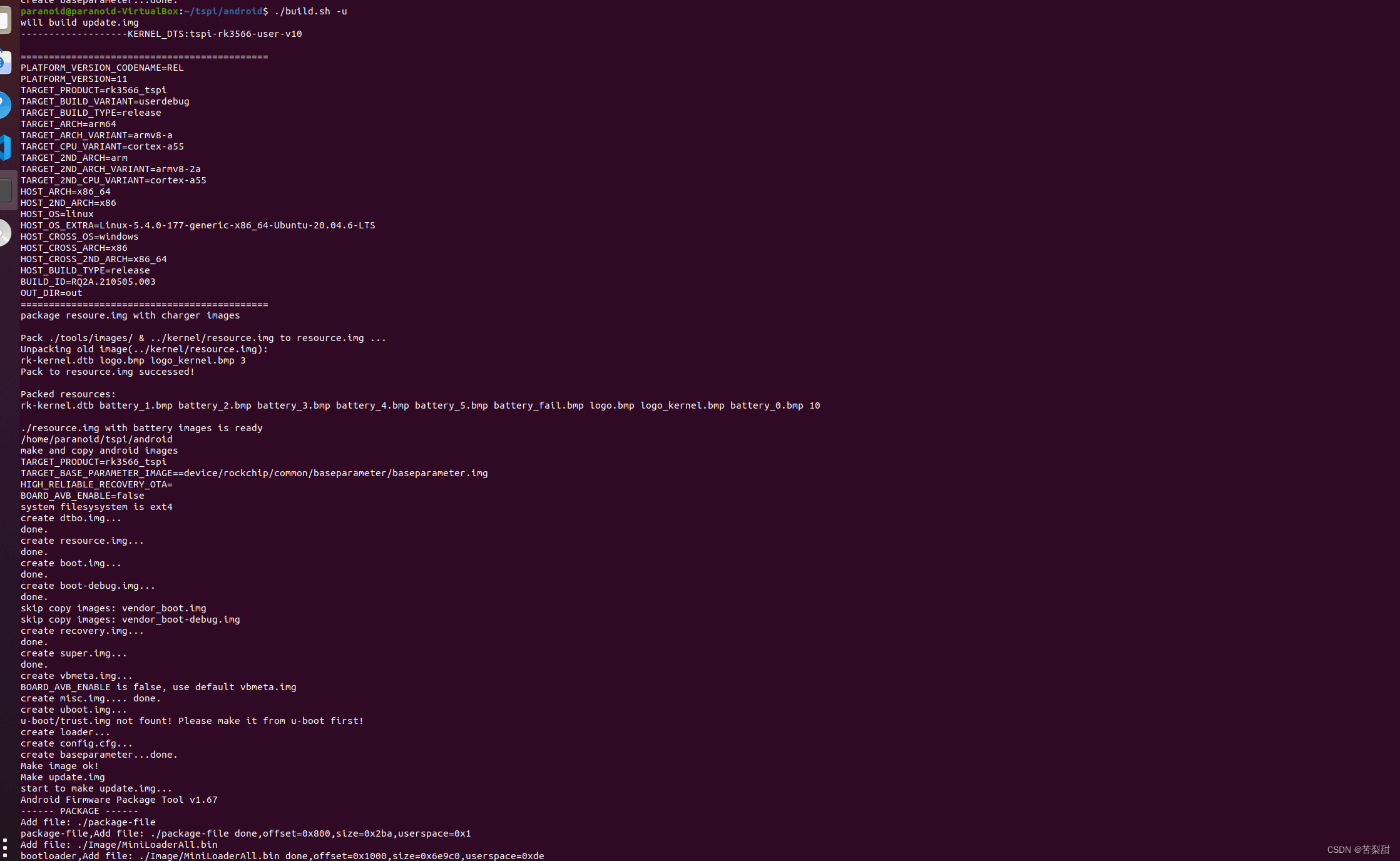
效果
触摸打印信息,表示生效
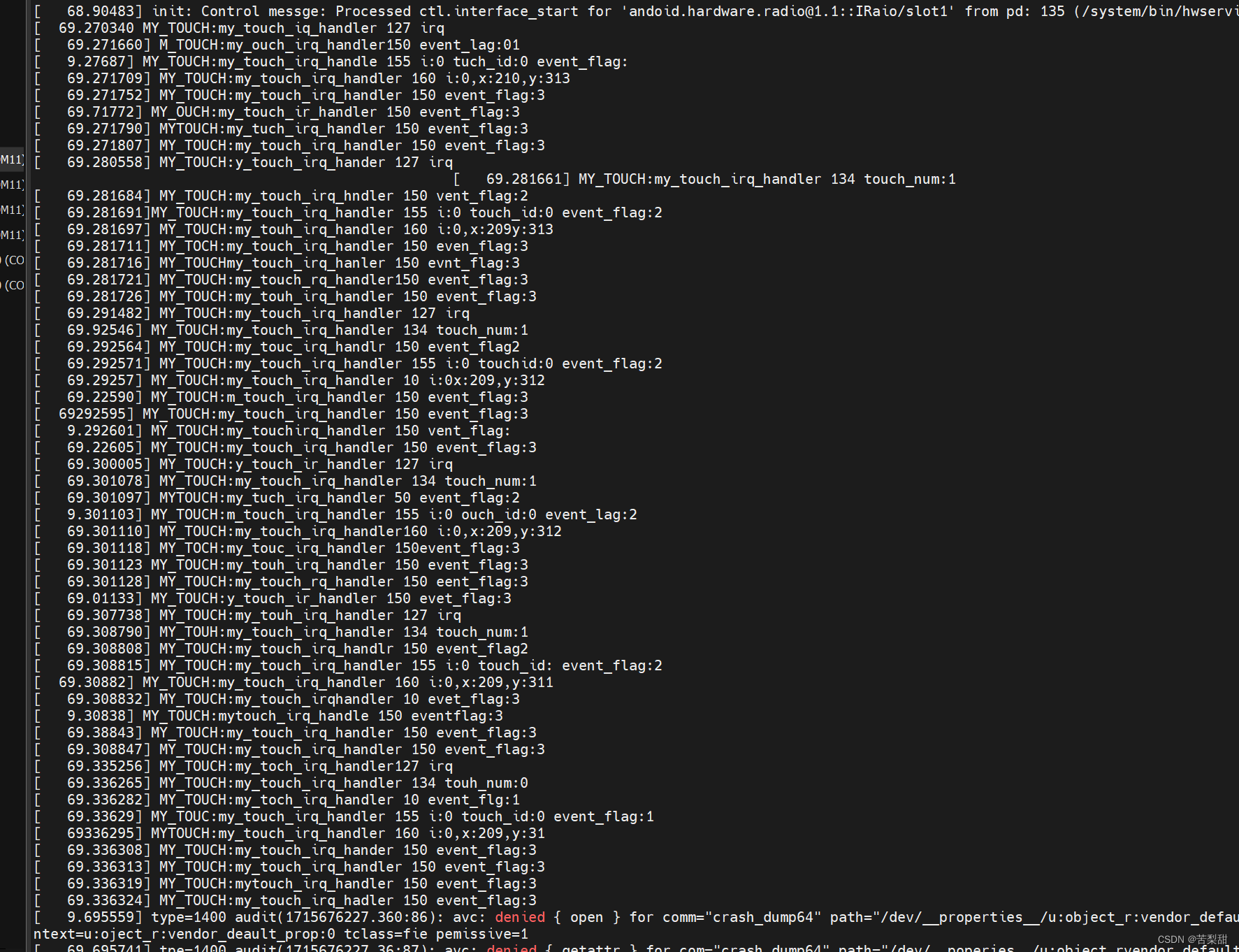
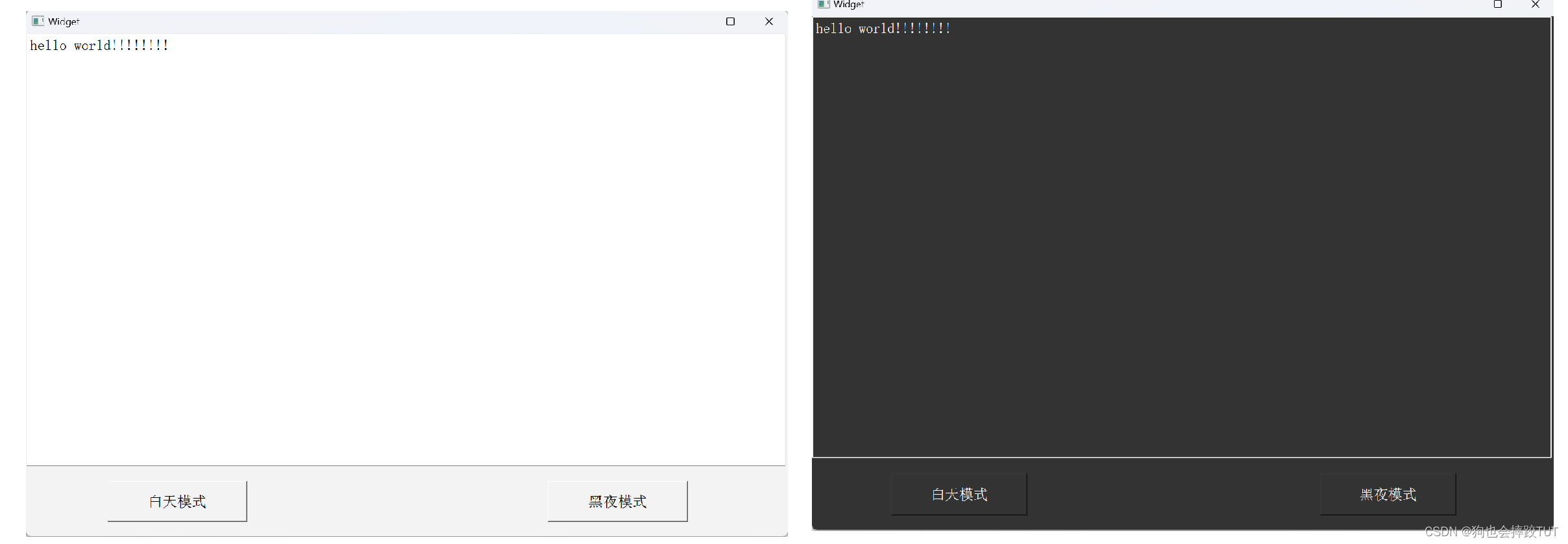


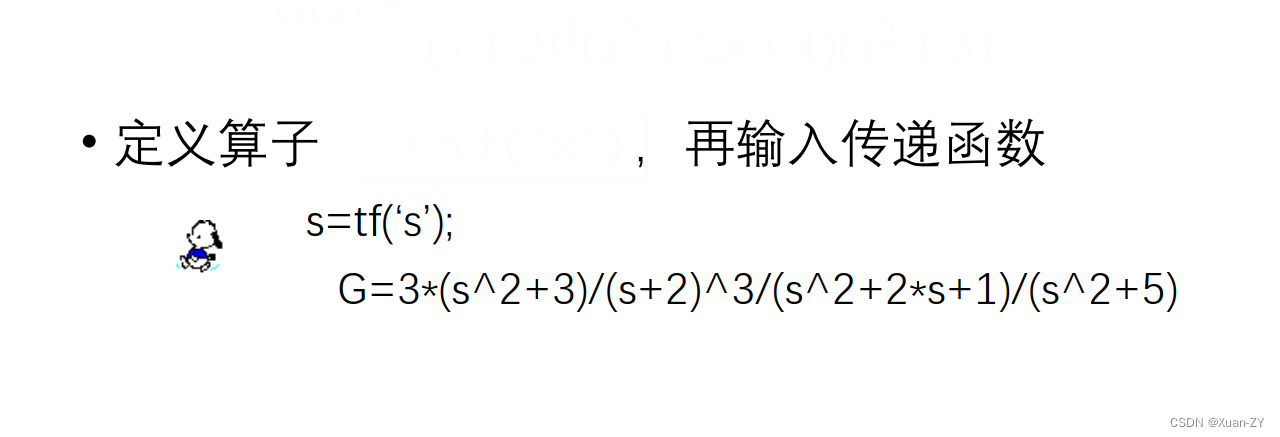







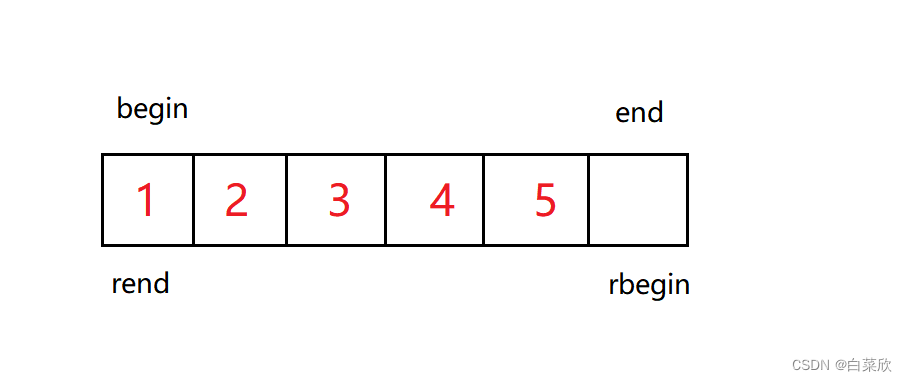

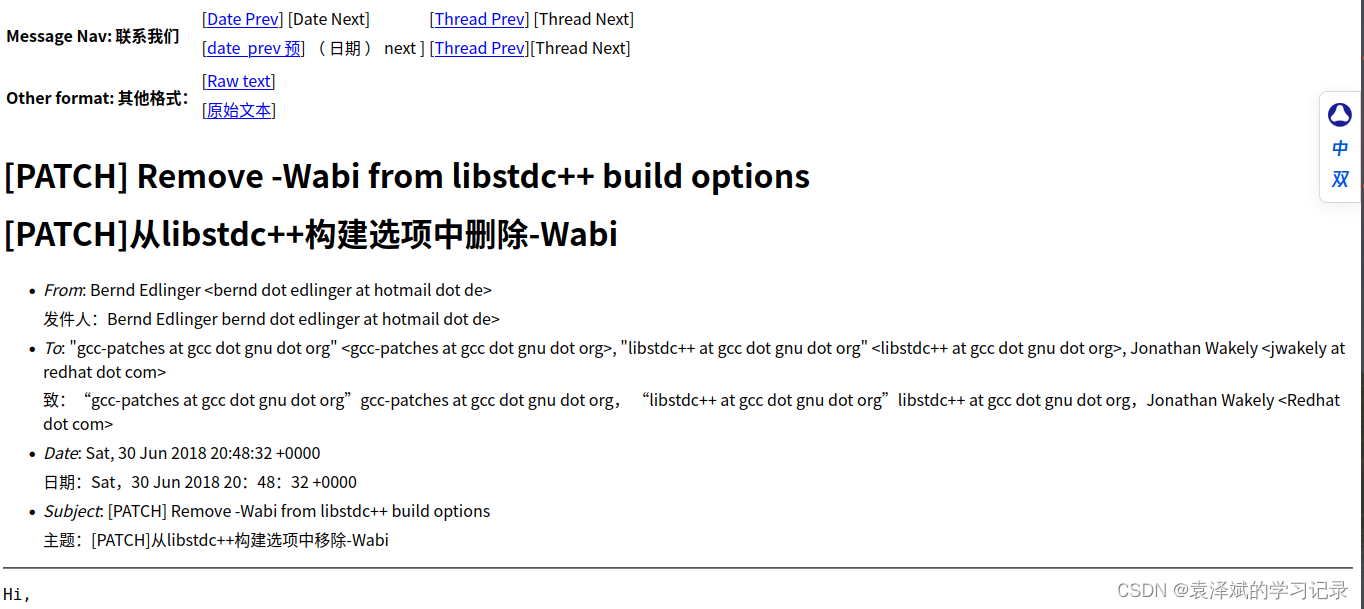
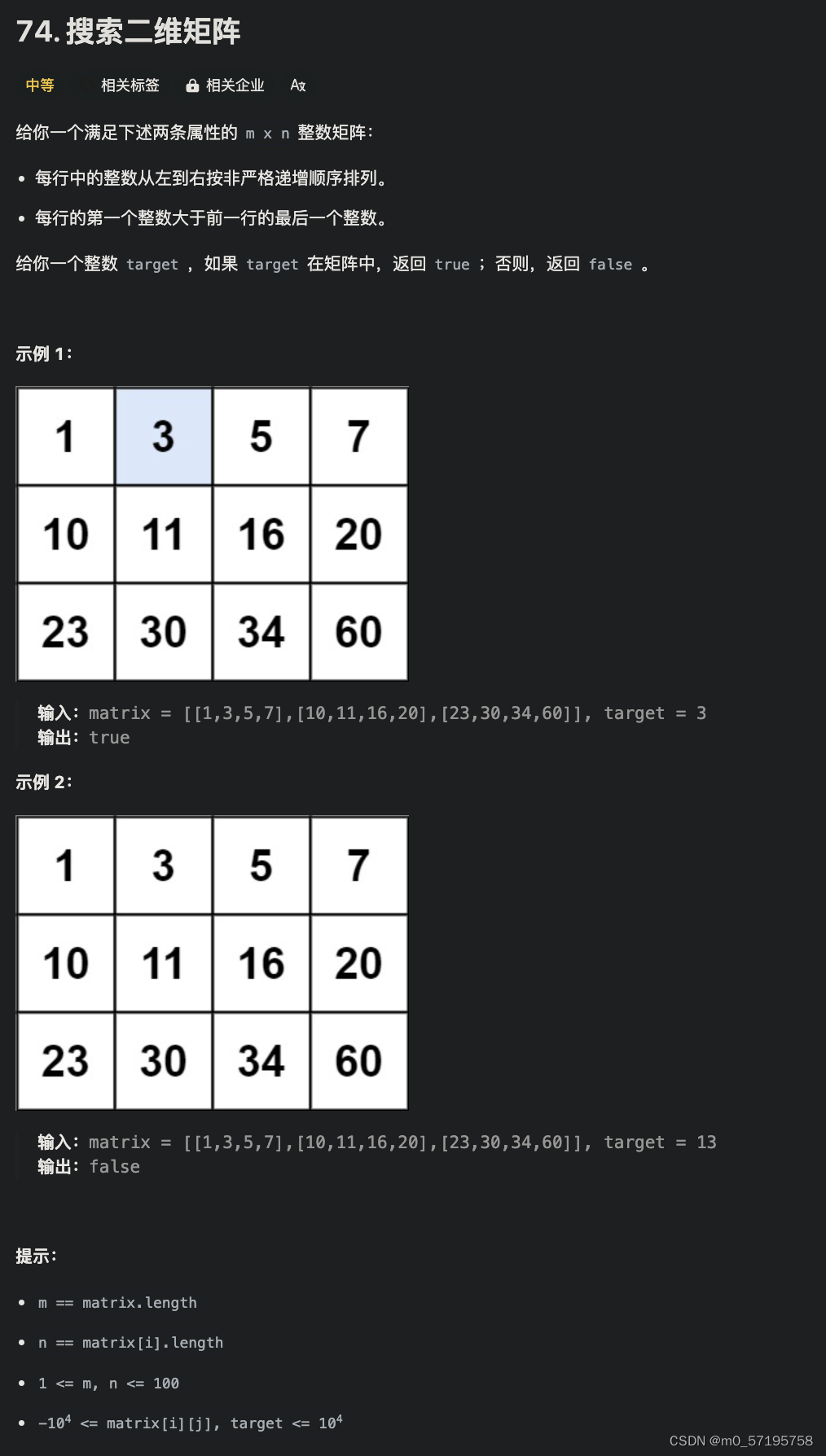

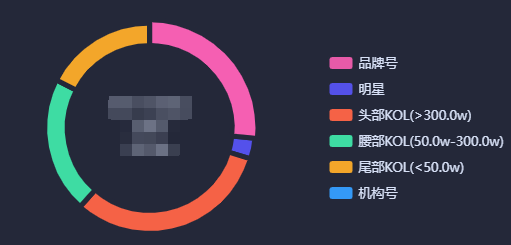
![[BJDCTF 2020]easy_md5、[HNCTF 2022 Week1]Interesting_include、[GDOUCTF 2023]泄露的伪装](https://img-blog.csdnimg.cn/direct/a39b3a1d254a4fb2beee31de7c9ae376.png)
